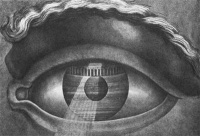Sensory nervous system
From The Art and Popular Culture Encyclopedia
(Redirected from Sensory system)

This page Sensory nervous system is part of the perception series.
Illustration: Drawing for the interior view of the Théatre de Besançon (1784) by Claude Nicolas Ledoux
Illustration: Drawing for the interior view of the Théatre de Besançon (1784) by Claude Nicolas Ledoux
|
Related e |
|
Featured: |
The sensory nervous system is a part of the nervous system responsible for processing sensory information. A sensory system consists of sensory neurons (including the sensory receptor cells), neural pathways, and parts of the brain involved in sensory perception. Commonly recognized sensory systems are those for vision, hearing, touch, taste, smell, and balance. In short, senses are transducers from the physical world to the realm of the mind where we interpret the information, creating our perception of the world around us.
[edit]
Human sensory system
The human sensory system consists of the following subsystems:
- Visual system
- Auditory system
- Somatosensory system consists of the receptors, transmitters (pathways) leading to S1, and S1 that experiences the sensations labelled as touch, pressure, vibration, temperature (warm or cold), pain (including itch and tickle), and the sensations of muscle movement and joint position including posture, movement, and facial expression (collectively also called proprioception)
- Gustatory system
- Olfactory system
- Vestibular system
[edit]
Diseases
[edit]
See also
- Multisensory integration
- Neural adaptation
- Neural coding
- Sensor
- Sensory augmentation
- Sensory neuroscience
- Sensory systems in fish
Unless indicated otherwise, the text in this article is either based on Wikipedia article "Sensory nervous system" or another language Wikipedia page thereof used under the terms of the GNU Free Documentation License; or on research by Jahsonic and friends. See Art and Popular Culture's copyright notice.

